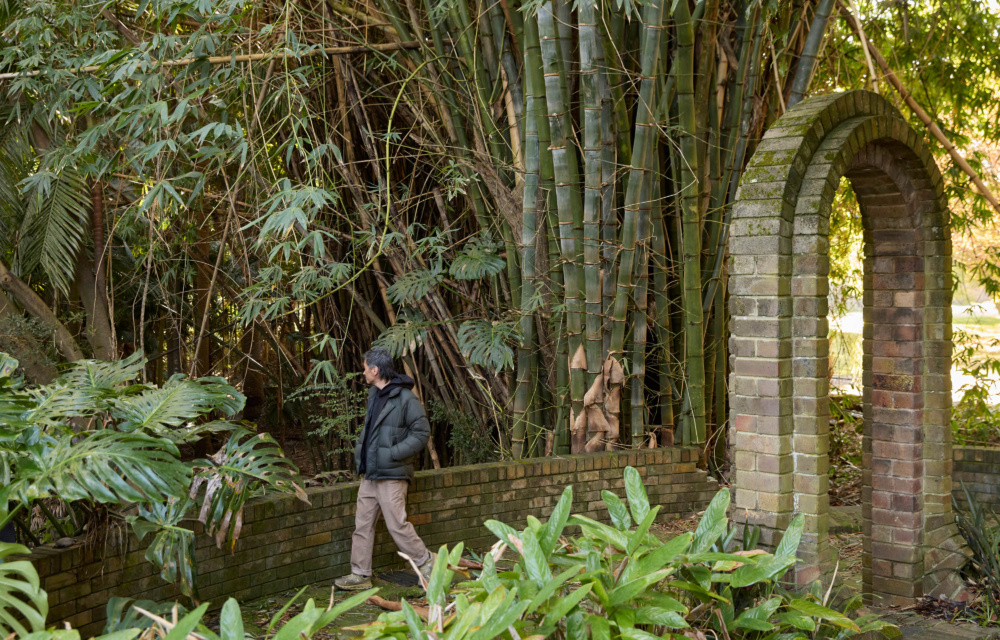Why This Former Hospital Is Architect Will Fung’s Favourite Garden
Gardens
Architect Will Fung’s favourite garden is Callan Park — particularly the rainforest planting surrounding the former Broughton Hall Psychiatric Clinic — which the architect visits every morning.
Known as The Arbour, or the rainforest gully, this lush area of Callan Park between Wharf and Glover streets was created in the 1920s and 30s to accompany Broughton Hall.
Will Fung, co-founder of CO-AP, is one of the designers revitalising the National Sculpture Garden at Canberra’s National Gallery of Australia.
Will’s favourite area of the park includes a stream and brick follies.
Bangalow palms and cabbage-tree palms tower above the grounds.
Will first discovered this area of Callan Park when picnicking with his partner Myles 15 years ago.
Will’s daily visits to Callan Park are a reminder of good landscape design that gives back to its users.
The Arbour demonstrates seasonal planting that evolves throughout the year.
The Japanese-style red-lacquer-painted arched bridge.
Callan Park was the first hospital in Australia to be designed and landscaped using the principles recognising the therapeutic role of landscape in treatment of mental illness.
The gardens continue to serve as a place of healing, respite and care for the public in Sydney’s inner west.
For architect Will Fung, co-founder of CO-AP, every morning starts with a dog walk in inner-west Sydney’s largest green space, Callan Park.
The Lilyfield grounds provide a tranquil environment for Will to clear his mind ahead of a day’s work on the National Sculpture Garden Revitalisation project at the National Gallery of Australia in Canberra.
Will is not alone. For decades, Callan Park and its grounds have served as a place of healing, respite and care, stemming back to its former days as a psychiatric hospital.
Originally a private estate established in the 1840s, the site and its buildings became the Callan Park Hospital for the Insane in 1878, then Broughton Hall Psychiatric Clinic from the 1920s, and Rozelle Hospital from 1976, until the last patients were transferred in 2008.
Callan Park was the first hospital in Australia to be designed and landscaped using the principles recognising the therapeutic role of landscape in treatment of mental illness, and the picturesque principles of landscape design.
‘Walks in nature and the outdoors became part of patient treatment, and the gardens became a fundamental part of the hospital,’ says Will.
Set alongside Parramatta River, Callan Park today comprises a picturesque mix of gardens, open space, historic buildings, and sporting fields managed by Greater Sydney Parklands and NSW Health.
There is a particular pocket of the 61-hectare parkland that Will is most drawn to.
Known as The Arbour, or the rainforest gully, this lush area of Callan Park between Wharf and Glover streets was created in the 1920s and 30s to accompany Broughton Hall. The area includes a stream, a Japanese-style red-lacquer-painted arched bridge, and brick follies among spectacular old lemon-scented gums, jacarandas, Bangalow palms, cabbage-tree palms, and Moreton Bay figs.
‘I love the scent of lemon scented gums at the entry to the park off Wharf Road,’ says Will. ‘In summer, the fragrance is intoxicating.’
Will first discovered this area of Callan Park when picnicking with his partner Myles 15 years ago. He describes the experience as love at first sight, and it was on the same day they also came across their future home near the park. ‘This is the home we bought and have lived in for over 15 years,’ says Will.
His first memory of visiting the National Gallery of Australia is equally distinct.
‘I moved to Canberra from Hong Kong with my family when I was six,’ says Will. ‘I remember visiting the National Gallery of Australia the first time in 1983 and saw an exhibition of the Terracotta Warriors from China. It was the first time I felt connected to my heritage and a connection to my new homeland.’
‘I have since moved to Sydney, but every time I visit Canberra I visit the Sculpture Garden. It holds a lot of nostalgia for me. Working on this project also means protecting its legacy.’
Will’s architectural practice CO-AP is part of a multi-disciplinary design team including Studio JEF, TARN, and Plus Minus Design working to collectively revitalise the National Sculpture Garden. Their vision combines care and a deep understanding of the heritage and legacy of the three-hectare site, with an ambition to enhance the garden as a global destination.
‘Our aim is to do as little as possible but as much as necessary,’ says Will.
‘We adore the existing Sculpture Garden originally designed by Harry Howard, Barbara Buchanan, and Roger Vidler. We propose to renew the existing garden while introducing new planting overlays, to embed ongoing care and stewardship and to connect to Country.
‘The site has so much scope for ambition and progression without the destruction of what is important.’
Will’s daily visits to Callan Park are a reminder of good landscape design that gives back to its users.
Whether it’s a crisp foggy winter morning, or a vibrant late spring day under the flowering jacarandas, The Arbour demonstrates seasonal planting that evolves throughout the year, and responds and adapts to its users over time.
‘It feels like home,’ says Will.
The Design Files is partnering with the National Gallery to bring you stories about Australia’s most beautiful gardens, chosen by the Gallery’s Sculpture Garden Revitalisation project design team. Find out more here.

